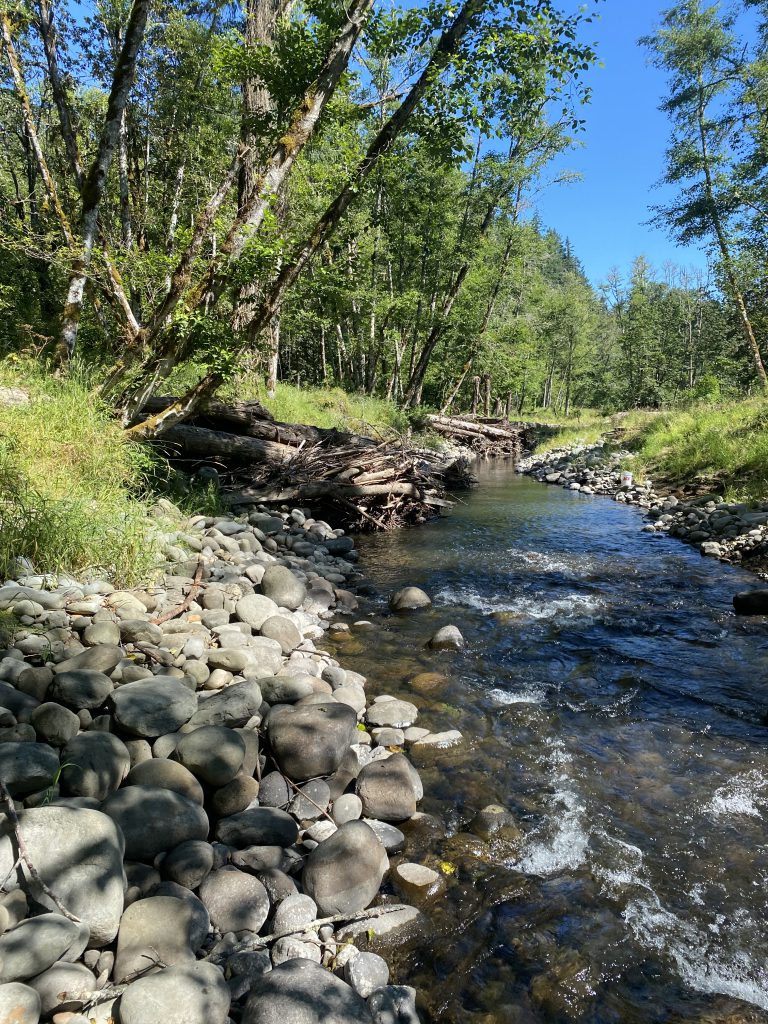Just a stone’s throw from where disc golfers, anglers, campers and park-goers convene at Milo McIver State Park, the Clackamas River Basin Council and their partners have been busy improving habitat for threatened and endangered native fish species. The project, known as the Kingfisher Side-Channel Reconnection project, wrapped up construction in September 2021, which entailed reconnecting and enhancing a 1,700’ side-channel off the Clackamas River, increasing fish access to riparian floodplain areas.

Side-channels and their riparian areas, which are complex habitat systems consisting of floodplains, ponds, and woody habitat structures, provide necessary rearing habitat for young fish migrating downstream from their primary spawning habitat. Today, there are few remaining high quality floodplain habitats in the Lower Clackamas River Basin. Development, timber harvest and other habitat altering activities change natural river systems and cause these side-channels to dry up. Salmon and many other fish populations are declining in some fish runs to the point of being listed on the federal Endangered Species List (ESA), and access to floodplains is one of the limiting factors impacting these fish.
*Right: Photo of Kingfisher side channel in July, 2022.
“That’s exactly what this project addresses,” says Cheryl McGinnis, Clackamas River Basin Council’s Executive Director. “This reconnection project will breathe life into this side-channel and improve juvenile rearing conditions for spring Chinook Salmon, Coho Salmon, and steelhead by providing them with a safe space to grow and thrive outside of the Clackamas River mainstem.”
Eric Butler, Clackamas River Basin Council’s Riparian Specialist says, “In addition to the instream work, we’ve put great effort into re-establishing native vegetation around this side-channel. A diverse and structurally complex native plant community will provide long-lasting benefits for water temperature, water quality, and a productive food web—all of which are essential for salmonids and for countless other species of wildlife.”
The construction phase of the Kingfisher project involved digging a deeper side-channel waterway, removing boulders at the channel entrance to increase flow, and installing log jams throughout which create pools that will persist even in low flow periods. With these enhancements, juvenile fish, along with many other species, will have important habitat at this site during every month of the year.
After the construction phase, 11,000 native trees and shrubs were installed in February 2022, to be followed by three years of maintenance for the plants to reach free to grow status.
Despite the listing of several fish species on the ESA list, the Clackamas River and its streams still support some of the healthiest fish populations in the region. With help from restoration projects such as this, populations of spring Chinook salmon, and winter steelhead are trending in a positive direction.
The Clackamas River Basin Council is part of the Clackamas Partnership, a group of organizations who voluntarily committed to a collaborative approach to improve watershed health. The Clackamas Partnership created the Strategic Restoration Action Plan, a plan that guides their collaborative approach to restoration activities in the Clackamas River Basin. The Clackamas Partnership is funded by the Oregon Water Enhancement Board through their Focused Investment Partnership (FIP) Implementation grant and other local, state and federal grants. The Kingfisher Side-Channel Reconnection project is a piece of this larger restoration Strategic Action Plan, where limiting factors and threats imperiling salmon are identified and addressed. Other partners Oregon State Parks, the Oregon Department of Fish and Wildlife, and Portland General Electric.
The Clackamas River Basin Council is a 501(c)(3) nonprofit with the mission of fostering partnerships for clean water and to improve fish and wildlife habitat and the quality of life for those who live, work and recreate in the watershed.